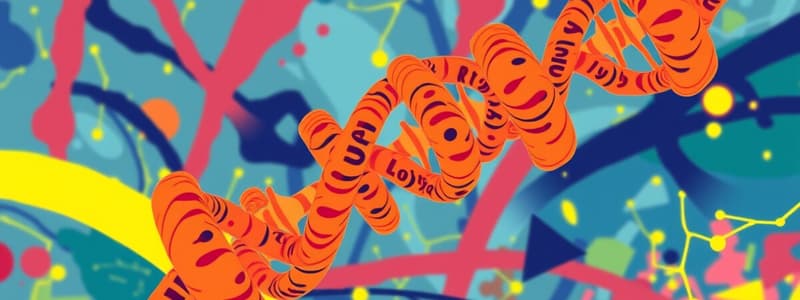Podcast
Questions and Answers
What triggers the initiation of contraction in muscle cells?
What triggers the initiation of contraction in muscle cells?
- A calcium signal (correct)
- Increase in ATP levels
- Decrease in cytosolic pH
- Activation of tropomyosin
What role does troponin play during muscle contraction?
What role does troponin play during muscle contraction?
- It pulls tropomyosin away from actin’s binding site (correct)
- It strengthens the actin-myosin bond
- It blocks the myosin-binding site on actin
- It increases ATPase activity in myosin
What is the outcome of the power stroke in muscle contraction?
What is the outcome of the power stroke in muscle contraction?
- Myosin detaches from actin
- Actin filaments move (correct)
- Actin filaments lengthen
- Troponin is inactivated
Which molecule binds to troponin to initiate the contraction process?
Which molecule binds to troponin to initiate the contraction process?
How does the role of tropomyosin change during muscle contraction?
How does the role of tropomyosin change during muscle contraction?
What is the relationship between ADP and the power stroke?
What is the relationship between ADP and the power stroke?
What happens to cytosolic Ca2+ levels prior to muscle contraction?
What happens to cytosolic Ca2+ levels prior to muscle contraction?
What occurs after myosin binds strongly to actin during contraction?
What occurs after myosin binds strongly to actin during contraction?
What initiates muscle contraction according to the described process?
What initiates muscle contraction according to the described process?
What is the role of calcium ions in muscle contraction?
What is the role of calcium ions in muscle contraction?
What happens to tropomyosin when calcium binds to troponin?
What happens to tropomyosin when calcium binds to troponin?
Which of the following correctly describes the power stroke?
Which of the following correctly describes the power stroke?
What is the result when a muscle fiber is at its optimal length before contraction?
What is the result when a muscle fiber is at its optimal length before contraction?
What is the effect of increased cytosolic calcium on tropomyosin?
What is the effect of increased cytosolic calcium on tropomyosin?
What is the final result of the power stroke in muscle contraction?
What is the final result of the power stroke in muscle contraction?
Which term refers to the weight or force that opposes contraction?
Which term refers to the weight or force that opposes contraction?
What role does cytosolic Ca2+ play in muscle contraction?
What role does cytosolic Ca2+ play in muscle contraction?
What occurs during summation in muscle contractions?
What occurs during summation in muscle contractions?
What state must myosin be in to effectively bind to actin?
What state must myosin be in to effectively bind to actin?
What occurs immediately after calcium binds to troponin?
What occurs immediately after calcium binds to troponin?
What is the effect of increased Ca2+ levels in the cytosol?
What is the effect of increased Ca2+ levels in the cytosol?
Which of the following best describes the relationship between crossbridges and muscle tension?
Which of the following best describes the relationship between crossbridges and muscle tension?
How does the troponin-Ca2+ complex affect tropomyosin?
How does the troponin-Ca2+ complex affect tropomyosin?
What is the relationship between calcium ions and the actin-myosin interaction?
What is the relationship between calcium ions and the actin-myosin interaction?
What defines a single twitch in muscle contraction?
What defines a single twitch in muscle contraction?
Which protein moves away from actin's myosin-binding site during contraction?
Which protein moves away from actin's myosin-binding site during contraction?
Which molecule primarily facilitates the exposure of actin's binding site during contraction?
Which molecule primarily facilitates the exposure of actin's binding site during contraction?
What triggers the initial signal for muscle contraction?
What triggers the initial signal for muscle contraction?
Which of the following statements is true regarding tropomyosin during muscle contraction?
Which of the following statements is true regarding tropomyosin during muscle contraction?
What is the immediate consequence of Ca2+ binding to troponin?
What is the immediate consequence of Ca2+ binding to troponin?
What does the presence of Pi indicate in the context of muscle contraction?
What does the presence of Pi indicate in the context of muscle contraction?
What is the effect of ADP during muscle contraction?
What is the effect of ADP during muscle contraction?
What occurs during the power stroke cycle of muscle contraction?
What occurs during the power stroke cycle of muscle contraction?
What must happen to myosin to release it from actin?
What must happen to myosin to release it from actin?
In the sliding filament theory, what causes the actin and myosin filaments to slide past each other?
In the sliding filament theory, what causes the actin and myosin filaments to slide past each other?
What condition is described by muscles freezing due to lack of ATP?
What condition is described by muscles freezing due to lack of ATP?
What role do satellite cells play in muscle physiology?
What role do satellite cells play in muscle physiology?
During muscle relaxation, what happens to calcium ions?
During muscle relaxation, what happens to calcium ions?
What is the function of flexor muscles?
What is the function of flexor muscles?
What characterizes skeletal muscle fibers?
What characterizes skeletal muscle fibers?
What is the role of myosin during the contraction cycle?
What is the role of myosin during the contraction cycle?
What constitutes an antagonistic muscle group?
What constitutes an antagonistic muscle group?
Flashcards are hidden until you start studying
Study Notes
Muscle Contraction Overview
- Muscle contraction is initiated by calcium (Ca2+) signals increasing cytosolic Ca2+ levels.
- Tropomyosin shifts to expose myosin-binding sites on actin upon Ca2+ binding to troponin (TN).
- The troponin-Ca2+ complex pulls tropomyosin away from actin’s binding sites.
- Following the binding of myosin to actin, the power stroke occurs, moving the actin filament.
Sliding Filament Theory
- Actin and myosin slide past each other during muscle contraction.
- The power stroke cycle involves:
- Calcium release from T-tubules activating troponin.
- Troponin displacing tropomyosin, allowing myosin to bind to actin.
- Myosin moving actin and remaining tightly bound until ATP binds to myosin.
- ATP breakdown allows for myosin to prepare for another stroke; this rotation is crucial for the binding process.
- Absence of ATP leads to rigor mortis, where muscles "freeze" due to myosin’s inability to release actin.
- Relaxation occurs when calcium ions are pumped back into the sarcoplasmic reticulum.
Skeletal Muscle Structure
- Skeletal muscle fibers are multi-nucleated and arise from fused cells.
- Muscle fibers are organized into fascicles, surrounded by connective tissue.
- Muscles are attached to the skeleton via tendons:
- Origin: point of attachment closest to the trunk.
- Insertion: point of attachment further from the trunk, typically more mobile.
- Muscle actions include:
- Flexors: bring bones closer together.
- Extensors: move bones apart.
- Antagonistic pairs (flexors vs. extensors) coordinate movement.
Length-Tension Relationships
- Sarcomeres generate optimal contraction force at an ideal length between too long and too short.
- Tension produced by a muscle is directly proportional to the number of crossbridges formed between thick (myosin) and thin (actin) filaments.
Contraction Dynamics
- Muscle tension represents the force generated during contraction, while load refers to opposing weight or force.
- Contraction involves:
- Events at the neuromuscular junction.
- Excitation-contraction coupling.
- Sliding filament mechanism.
- Relaxation follows contraction, releasing muscle tension.
Contraction Summation
- Single twitches allow complete relaxation between stimuli.
- Summation occurs when multiple stimuli are received closely together, resulting in stronger contractions as the muscle does not relax fully.
Studying That Suits You
Use AI to generate personalized quizzes and flashcards to suit your learning preferences.




